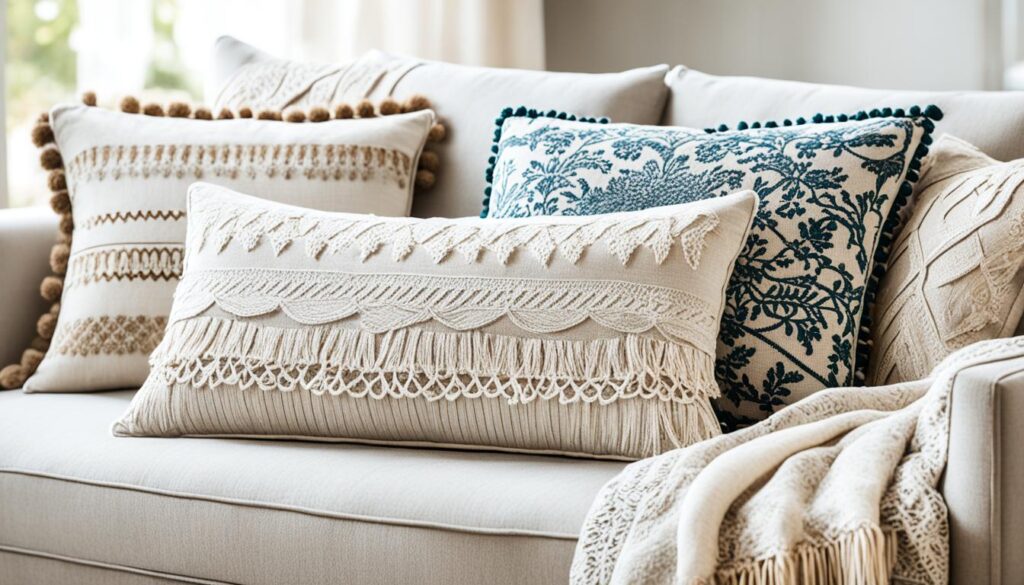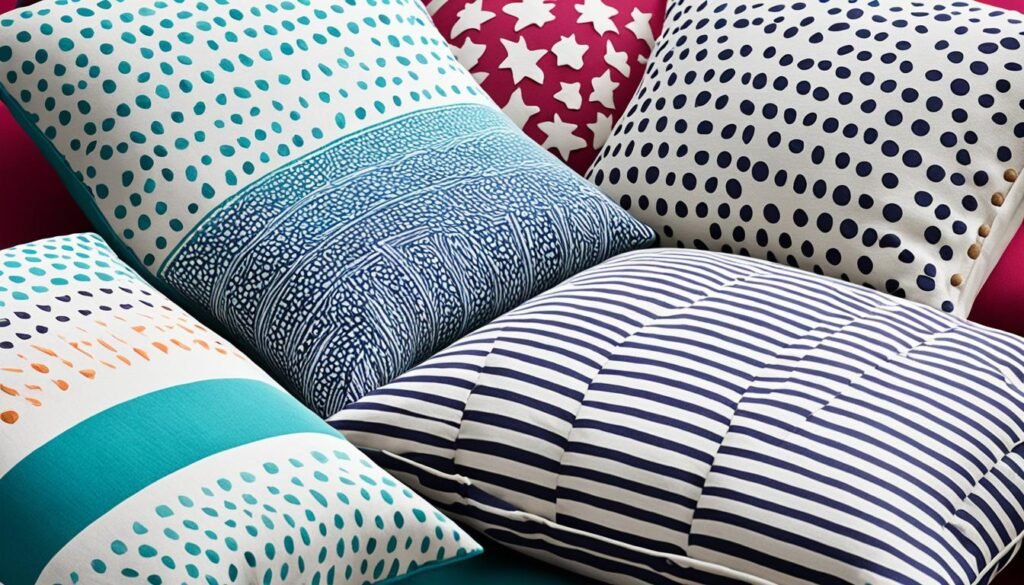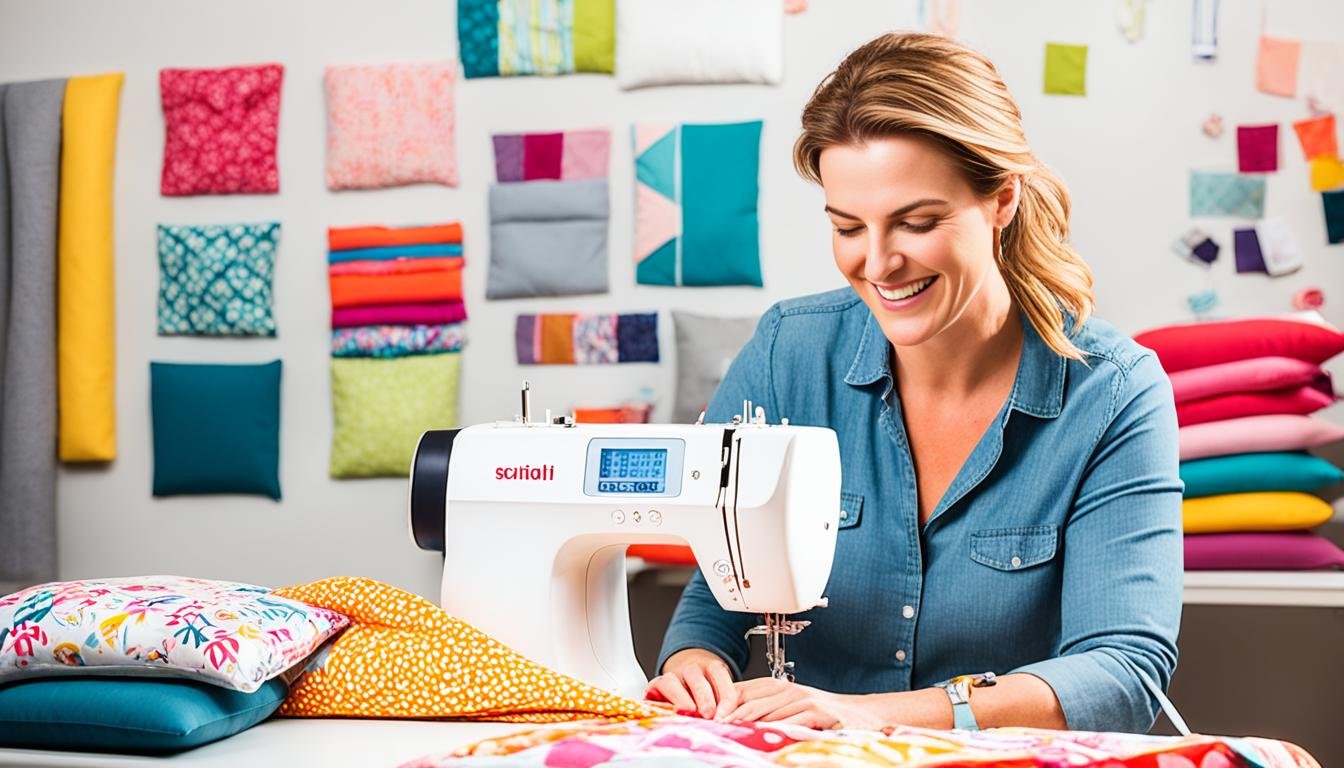Making your own custom pillow cover is easy and budget-friendly. This guide will show you how to make a beautiful pillow cover quickly. It’s perfect for both beginners and those with sewing experience. You’ll soon be making stylish coverings with our step-by-step instructions. How to Make a Pillow Cover?
Key Takeaways:
- Creating your own pillow cover allows you to customize your home decor while saving money.
- Whether you’re a beginner or experienced, this guide will assist you in making a beautiful pillow cover.
- Gather the necessary supplies, including a sewing machine, fabric, thread, zipper foot, invisible zipper, iron, and ironing board.
- Follow the step-by-step instructions to cut the fabric, resize the zipper, and sew the cover.
- Use helpful tips such as precise cutting, using 100% cotton fabric, having extra fabric on hand, and using zig-zag stitches for a professional finish.
Supplies Needed for Making a Pillow Cover
Before starting your pillow cover project, gather all you need. Here’s a list to help:
- Sewing machine
- Fabric (enough for two 19″ x 19″ squares)
- Thread
- Zipper foot
- 18″ or longer invisible zipper
- Iron
- Ironing board
If you want to be creative, look at different pillow cover design ideas. Pick a fabric that fits your home’s style. You can choose vibrant or subtle, as you wish!
If you’re short on time or the supplies to make a pillow form, you can use something else. Either upcycle a bed pillow for stuffing, or get a pre-made form.
Getting these supplies ready will make making your pillow cover fun. Now, let’s move to the next part – a guide on making your custom pillow cover!
Step-by-Step Instructions for Making a Pillow Cover
Ready to craft your own pillow cover? Just follow these easy steps. You’ll soon have a beautiful, pro-like pillow cover:
- First, set up your sewing machine and get all your tools ready.
- Next, cut two 19″ x 19″ squares from your fabric. Be sure to match any patterns or stripes.
- Size down your invisible zipper to 18″ if needed. Do this by sewing a zipper stop at the end.
- Flatten the zipper’s teeth with an iron on low heat.
- Now, place the zipper face down on one fabric square. Line up the edges, and pin it down.
- Use a zipper foot to sew it on, close to the teeth.
- Repeat the last two steps for the other fabric square. Match its pattern with the first square.
- Half unzip the zipper to avoid catching it in the sew.
- With the zipper foot in place, pin the squares together inside out.
- Sew around the edges, leaving a 1/2″ gap.
- Take out the pins and cut off any extra fabric from the corners.
- Turn the cover’s right side out through the zipper.
- Use a pencil or your finger to poke the corners out for a neat shape.
- Stuff your pillow or form inside, through the open zipper.
- Finally, zip close your cover. It’s finished!
With this pillow cover sewing tutorial down, try out more patterns. This lets you make trendy, one-of-a-kind covers for your space.
Additional Tips:
- Wear your style with fabrics that match your taste and home look.
- Make it yours by adding fun touches like embroidery or trim.
- Explore closure styles like buttons or envelopes for something unique.
- For a pro touch, always mind your seam allowances.
- Mix and match different textures and prints for an interesting design.
Tips for Perfect Pillow Covers

For a top-notch look, use these tips for your pillow covers. They’ll make your sewing shine:
- Use the right tools: Grab a rotary cutter, acrylic ruler, and mat for precise cuts. These ensure your lines are clean, giving a pro finish.
- Opt for 100% cotton fabrics: Beginners should start with cotton. It’s easy to work with and lets you focus on your sewing technique.
- Always have extra fabric: Mistakes are common in sewing. Keep extra fabric to fix any errors during your project.
- Start fresh: Use a new needle and thread for every project. A fresh needle means smooth stitches, and new thread prevents breaking.
- Keep a seam ripper handy: A seam ripper helps fix errors. It’s key to making your cover look flawless.
- Consider using zig-zag stitches: Add zig-zag stitching to your pillow’s edges. This stitching stops fraying, making your cover last longer and look professional.
With these techniques, you’ll make pillow covers that beautify your home.
Comparison of Different Fabric Materials for Pillow Covers
| Fabric Material | Pros | Cons |
|---|---|---|
| Cotton | Easy to work with Wide variety of patterns and textures Naturally breathable and hypoallergenic | May wrinkle easily Requires ironing to maintain appearance Not as durable as some synthetic fabrics |
| Polyester | Durable and resistant to wrinkles Available in a range of colors and designs Easy to clean and care for | Can feel less comfortable and breathable May generate static electricity Prone to pilling |
| Linen | Natural and eco-friendly Has a unique texture and drape Becomes softer and more comfortable over time | Can be more expensive than other fabrics Requires careful ironing to maintain appearance May show creases and wrinkles more prominently |
Styling Your How to Make a Pillow Cover

Now that your pillow cover is done, make it stand out in your place. You can style it in many ways that match your taste and decor. Here are some ideas:
- Mix and match: Use your custom-made pillow with others to make a cozy spot on your sofa or couch.
- Add decorative elements: Iron on pretty designs or use stencils to give your pillow cover unique looks.
- Create a personalized touch: Use fabric markers or do embroidery to add quotes or designs that show who you are.
- Layer with a blanket: Makes things extra comfy by putting a blanket under your pillow cover.
- Coordinate colors: Mix different pillow covers to make your bed or couch look great.
Let your creativity shine when styling your pillow cover. Mix colors, play with textures, and express your style. Your pillow cover is more than just for looks; it’s a piece of your home decor that shows your unique touch.
Top Trends in Pillow Cover Design
Looking at the latest trends might give you new ideas. Let’s see what’s trending:
| Trend | Description |
|---|---|
| Botanical Prints | Wow your home with plant prints on your pillows. They’re vibrant and full of life. |
| Geometric Patterns | Make things modern with geometric patterns on your pillows. They’re bold and catch the eye. |
| Textured Fabrics | Feel the fun with pillow covers made of textured materials. They could be velvet, knits, or embroidery. |
| Bohemian Vibes | Get a boho-chic look with pillows that have fun patterns, fringe, and bright colors. |
| Monochrome Minimalism | Keep it simple with pillows in neutral colors and clean designs. It’s a sleek, minimalistic look. |
Take inspiration from these trends, but make your pillow cover your own. Add your style to create something special for your home.
Conclusion
Making your own pillow covers can be fun and rewarding. You just need some supplies and basic sewing skills. This lets you create beautiful covers for your home.
If you want your home to look modern, bohemian, or classic, you have many design choices.
Start by gathering materials and using the step-by-step guide. Let your creativity show in every stitch. This DIY tutorial will help you change your home with pillow covers that show your style.
Don’t only use store-bought covers. Create your own to match your taste. It just takes a little time and effort. Soon, you’ll have unique pillow covers for any room. Enjoy sewing!






